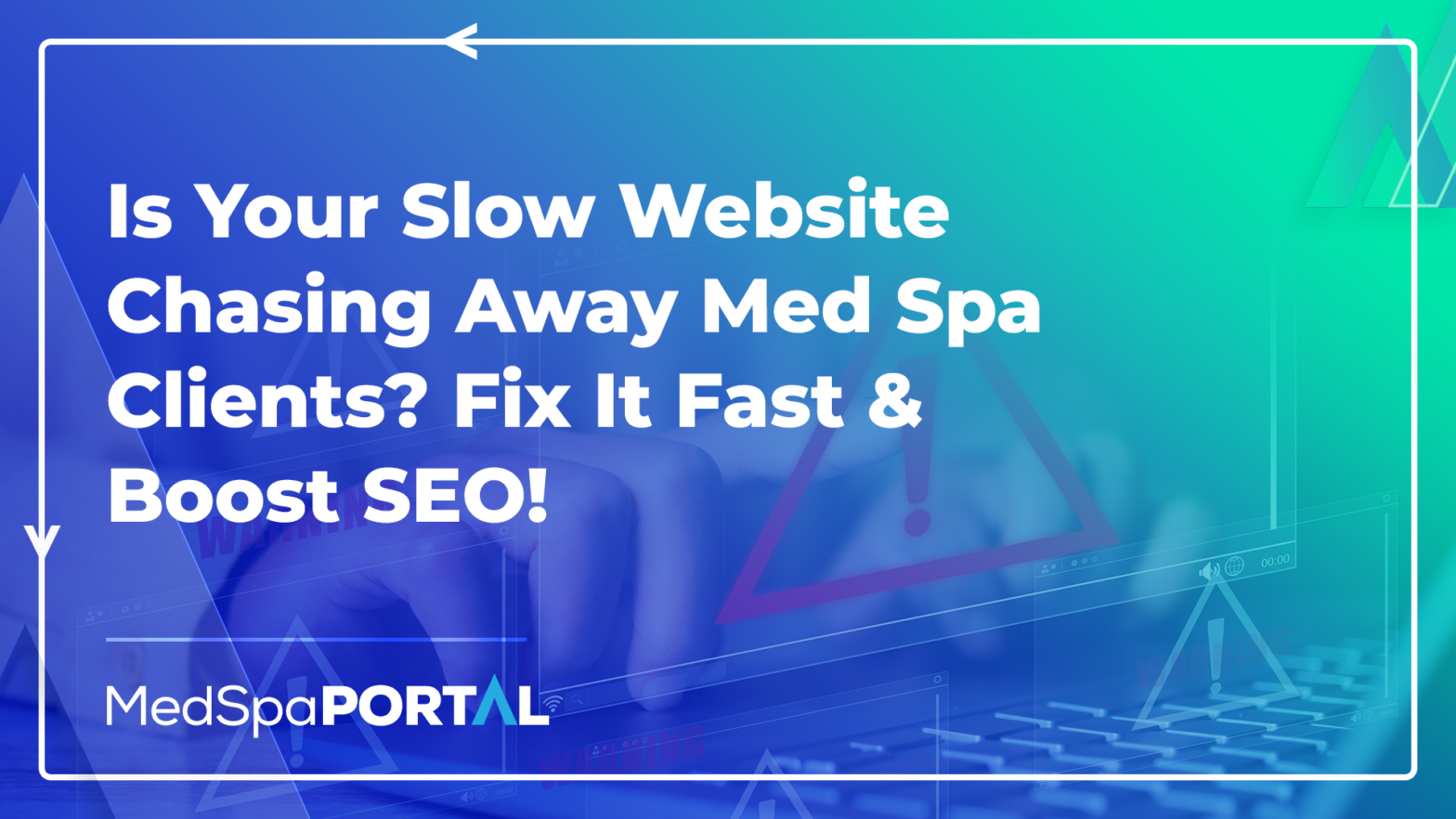At A Glance
- Why Website Speed Impacts Revenue – Slow websites hurt your bookings, bounce rates, and online reputation.
- Speed vs. SEO Rankings – Fast websites aren’t just preferred by users—Google favors them, too.
- Actionable Tips to Fix a Slow Website – Easily implementable solutions to improve speed and keep clients engaged.
- Tools to Audit Performance – Test your website’s speed with free tools that pinpoint bottlenecks and inefficiencies.
If you think a slow website is just a minor inconvenience, think again. It could be the reason clients are leaving before they even get to explore your services. A sluggish website isn’t just a technical problem—it’s a business one.
In today’s fast-paced digital world, your website serves as the front door to your business. If it’s slow, it won’t matter how amazing your treatments are; visitors will associate slow load times with poor quality and move on to your competitor’s faster, more user-friendly site.
A faster website does more than just enhance user experience. It drives conversions, improves client retention, and boosts your SEO. This blog will explore why speed matters, how to identify issues, and what strategies you can implement to ensure your website delivers the seamless experience that your med spa clients expect.
Why Website Speed Influences Revenue
Every med spa owner invests time and money into marketing, whether it’s through social media ads, email campaigns, or paid search. However, all those efforts lose impact if your website is slow. Studies show that just a one-second delay in load time can result in an average 7% drop in conversions.
For a med spa business, this could equate to thousands of dollars lost every month due to unrealized bookings. A prospective client searching for Botox, skincare treatments, or laser hair removal services online expects instant access to information. If they don’t get it, they don’t hesitate to leave and find another provider.
The 3-Second Rule
According to statistics, 53% of visitors will leave a site if it takes longer than three seconds to load. The med spa industry depends on creating professional and luxurious interactions from the first client touchpoint. If your website takes too long to load, clients will see it as unprofessional and chaotic, even if the reality is far from that.
Delivering a fast browsing experience isn’t just about convenience—it’s about ensuring potential clients take the next step toward booking your services. Every fraction of a second matters.
Bounce Rates and Lost Opportunities
Bounce rate measures the percentage of visitors who leave your website after checking out only one page. High bounce rates are a symptom of an unsatisfying user experience, often caused by slow loading times.
A slow med spa website means potential clients won’t have time to review testimonials, pricing, or your service offerings. Instead of browsing through options like facials, injectables, or body contouring services, they’ll simply exit your site and book with someone else.
How to Reduce High Bounce Rates
- Streamline Navigation: Use clear menus and service highlights that grab attention immediately.
- Optimize Above-the-Fold Content: Make the content load at the top of your homepage first.
- Upgrade to Fast Hosting Providers: Ensure that your hosting plan can deliver the speed and scalability needed for spikes in traffic.
- Use Browser Caching: Store website data locally for users who have previously visited your site to reduce load times on return visits.
Each of these steps ensures that visitors remain engaged with your website, leading them to explore and take action.
First Impressions and Trust
Your website is the digital storefront of your med spa business, and its performance often determines whether potential clients stay or go. Studies suggest that users form an opinion about a website within 50 milliseconds (that’s 0.05 seconds). If that first impression comes with slow load times or lag, they’re unlikely to stick around.
A slow website directly impacts trust. Visitors may assume that a site with outdated functionality correlates to outdated practices. For a beauty and wellness-focused industry like med spas, trust is everything. Clients have to know that you value quality, care, and efficiency before they’re willing to commit to treatments.
Build Credibility with Speed
Faster websites also enhance the perception of professionalism. When your website delivers instant results, clients feel reassured that you prioritize organization and efficiency. It sets expectations for the quality of treatments you provide and builds trust in your med spa’s expertise.
Additionally, sites optimized for speed demonstrate that you respect your client’s time. That simple action of reducing wait time online reflects the efficiency and value they can anticipate when visiting your spa in person.
The SEO and Speed Connection
Your website speed doesn’t just affect clients—it impacts where you show up in search engine results. Google has made it clear that faster websites rank higher because they deliver a better user experience. If your med spa’s page is slow, you risk being buried beneath competitors who’ve optimized their online performance.
Why Page Speed Matters to Google
- User Experience Signals: Google tracks how long users stay on your site. Slow speeds lead to quick exits, signaling to Google that your content is not engaging.
- Improved Crawl Rates: Search engines can index a fast-loading site more efficiently, improving overall reach within search listings.
- Mobile-First Indexing: With a growing number of users searching from smartphones, your website must load quickly on mobile platforms to stay competitive.
By speeding up your website, you’re not only catering to your clients but also giving search engines a reason to place you above competing med spas.
Actionable Steps to Speed Up Your Website
Boosting website speed doesn’t have to require a complete overhaul. Start with these practical steps:
- Compress Media Files: Ensure photos of your med spa’s services, like before-and-after shots or high-quality banners, are resized and optimized for web use.
- Implement a Content Delivery Network (CDN): A CDN distributes your site’s data across multiple global servers, providing users with faster access to your content.
- Minimize JavaScript and CSS: Eliminate unnecessary code and reduce script sizes wherever possible.
- Use Lazy Loading: Only load images and videos when users scroll down, reducing the initial time needed to display the page.
- Enable HTTP/2: Upgrade your website’s protocol to improve communication speeds between the server and browser.
By focusing on these areas, you can trim seconds off your load time and create a more streamlined experience.
Top Tools to Audit and Measure Website Performance
Not sure how your website fares? Use these free tools to diagnose problems and develop a better performance strategy:
- Google PageSpeed Insights: Provides detailed reports for mobile and desktop performance alongside user-friendly recommendations.
- GTmetrix: Offers in-depth analyses, timelines, and critical action points for improving site speed.
- Pingdom Tools: Allows you to test how fast your website loads from multiple global locations for better insight into performance variations by region.
- Lighthouse (via Google Chrome): A built-in tool that evaluates various aspects like speed, SEO compliance, and accessibility.
Interpreting Your Results
These tools generate reports highlighting problems like long load times, server delays, or oversized media files. Focus on reducing load times to under three seconds while addressing flagged inefficiencies.
Removing Hidden Bottlenecks
Even websites that seem simple and sleek can face hidden speed drains. Be sure to check for these common issues during your optimization process:
- Excessive Plugin Use: Only retain necessary plugins and extensions to avoid burdening your site with unnecessary functions.
- Old or Bloated Code: Review your HTML and CSS to pinpoint areas that could be streamlined.
- Unoptimized Fonts: Custom fonts are stylish but can slow performance. Consider using standard web-safe fonts or cutting down font weights/styles.
A commitment to regular website audits can uncover these bottlenecks early, preventing larger issues down the line.
Final Thoughts on Website Speed
Your website isn’t just a platform—it’s your digital storefront. Optimizing its speed is one of the simplest and most cost-effective ways to boost client acquisition, improve SEO rankings, and enhance the user experience.
Start today by testing your current website speed and implementing some of the tips shared above. Replace frustration with seamless navigation, and watch as more potential clients turn into loyal bookings.
A slow website can cost you—it’s time to fix it. Take control of your med spa’s online presence with MedSpa Portal and set the groundwork for long-term growth. Looking for expert advice? Schedule a recommendation session with MedSpa Portal today to unlock tailored solutions for optimizing your website and boosting performance.








